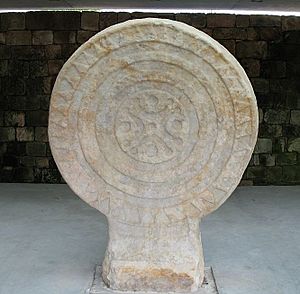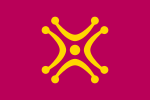Cantabrian stelae facts for kids
The Cantabrian stelae are large, round stone disks carved a long, long time ago in a region called Cantabria in northern Spain. These amazing stones were made in the centuries before the Roman Empire arrived and took over the area.
These ancient stone disks often have cool carvings like swastikas, triskeles (three-armed spirals), crosses, and other swirling patterns. Some even show warriors or symbols related to burials from before the Roman times.
The most famous one is called the Estela de Barros (Barros Stele). You can see it at the Parque de las Estelas (Stelae Park) in the town of Barros. This stele is so important that it's even on the official coat of arms of Cantabria today! Its design, a four-armed spiral called a tetraskelion, might have been linked to sun worship. The Barros stele is super big, which makes it special compared to smaller stelae found elsewhere in northern Spain. There's also another huge, broken stele at the same park.
Other stelae have been found and are now on display at the Regional Museum of Prehistory and Archaeology of Cantabria in Santander. These include two from Lombera and one from Zurita. The Zurita stele is interesting because it shows a vulture attacking a fallen warrior. Another one was found near an ancient fort called Espina del Gallego. We've also found pieces of other stelae, like a third one from Lombera and the Stele of San Vicente de Toranzo, which shows a Cantabrian warrior riding a horse.
The Cantabrian stelae are a very important clue about the Cantabri people who lived here before the Romans. They are also one of the most famous symbols of Cantabria even today. People continued to use similar stone disks in Cantabria during the Middle Ages and even later, but these newer ones sometimes lost their perfect round shape and had crosses instead of sun symbols. Disks like these were also common in other parts of northern Spain, like the Basque Country and Navarra.
Cantabrian Stelae Today
A modern version of these stelae, combined with an ancient Roman flag called the Cantabrum, led to the creation of the current Cantabrian lábaru. This flag isn't official, but many people in Cantabria use it.
Today, artists and stonemasons all over Cantabria still make copies of the old stelae or create new ones. They carve them from stone or wood, and sometimes use them to decorate new buildings. You can also find smaller versions of these stelae made from wood or metal, used as pendants or little figures. All of this shows how important the stelae are as a symbol of Cantabria.
Ancient Cantabrian Stelae
The ancient Cantabri people made many stelae. The most famous are the giant ones, and we know of five of them. Four of these huge stelae were found in the valley of Buelna. Experts believe they were made between the 1st century BC and the 1st century AD, though some might be even older, perhaps from the 5th or 6th century BC.
| Name | Size (cm) | Time Period | Where it was found |
|---|---|---|---|
| Barros Stele 1 |
|
Around 3rd century AD | Barros |
| Barros Stele 2 |
|
Unknown | Barros |
| Lombera Stele 1 |
|
Unknown | Los Corrales de Buelna |
| Lombera Stele 2 |
|
Unknown | Los Corrales de Buelna |
| Zurita Stele |
|
1st century BC - 1st century AD | Zurita |
| Name | Size (cm) | Time Period | Where it was found |
|---|---|---|---|
| Lombera Stele 3 |
|
Unknown | Los Corrales de Buelna |
| Luriezo Stele |
|
1st century AD | Luriezo |
| Toranzo Stele | Unknown | Unknown | Espina del Gallego |
See also
 In Spanish: Estelas cántabras para niños
In Spanish: Estelas cántabras para niños




